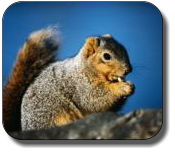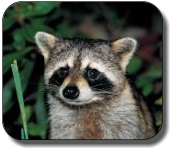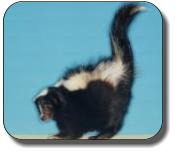













Squirrels
Squirrels are a frequent occurrence in this area and many sites contain a mother squirrel and her young. Live
traps will be set at the entry points where the squirrels are gaining access to the property. The animal will be
removed and any damage incurred to the structure will be repaired. Squirrels eat plants and fruit, dig up newly
planted bulbs and seeds, strip bark and leaves from trees and shrubs, invade homes, and consume bird eggs
They can cause problems by shorting out transformers and gnawing on power and telephone lines.


Moles
You can usually tell if you have a mole problem when you see the tell-tale surface runs in your yard. They can
cause major damage to an otherwise nice lawn. Lethal traps will be set to eliminate the problem. Live traps are
ineffective as the mole will find its way back or another mole will "move in." The mole discussed here is usually
referred to as the eastern mole. It is an insectivore, not a rodent, and is related to shrews and bats. True moles
may be distinguished from meadow mice (voles), shrews, or pocket gophers-with which they are often
confused-by noting certain characteristics. They have a hairless, pointed snout extending nearly ½ inch (1.3cm)
in front of the mouth opening. The small eyes and the opening of the ear canal are concealed in the fur; there
are no external ears. The forefeet are very large and broad, with palms wider than they are long. The toes are
webbed to the base of the claws, which are broad and depressed. The hind feet are small and narrow, with
slender, sharp claws. Out of the seven species that occur in North America, three inhabit lands east of the
Rocky Mountains (Yates and Pedersen 1982). The eastern mole is the most common.


Opossum
Opossums are a frequent occurrence in this area. Do not attempt to approach an opossum at any point, as they
can be very vicious and can carry rabies. A live trap will be set and the opossum will be removed immediately
upon capture. The premises will be evaluated to be sure no other nuisance animals are in the area. An opossum
is a whitish or grayish mammal about the size of a house cat. Under fur is dense with sparse guard hairs. Its
face is long and pointed its ears rounded and hairless. Maximum length is 40 inches (102 cm); the rat like tail is
slightly less than half the total length. The tail may be unusually short in northern opossums due to loss by
frostbite. Opossums may weigh as much as 14 pounds (6.3 kg); males average 6 to 7 pounds (2.7 to 3.2 kg)
and females average 4 pounds (6.3 kg). The skull is usually 3 to 4 inches (8 to 10 cm) long and contains 50
teeth, more than are found in any other North American mammal. Canine teeth (fangs) are prominent. Tracks of
both front and hind feet look as if they were made by little hands with widely spread fingers (Fig. 2). They may
be distinguished from raccoon tracks, in which hind prints appear to be made by little feet. The hind foot of an
opossum looks like a distorted hand.


Raccoons
Raccoons are one of our number one complaints in residential areas. They are quick and strong, so keep your
distance if you come across one in your backyard. We will catch the animal in a live trap and we can locate any
damage to the home or yard and make those repairs. Raccoons cause damage or nuisance problems around
houses and outbuildings when they seek to gain entrance to attics or chimneys or when they raid garbage in
search of food. In many urban or suburban areas, raccoons are learning that uncapped chimneys make very
adequate substitutes for more traditional hollow trees for use as denning sites, particularly in spring. In extreme
cases, raccoons may tear off shingles or fascia boards in order to gain access to an attic or wall space.
Raccoons also can be a considerable nuisance when they roll up freshly laid sod in search of earthworms and
grubs. They may return repeatedly and roll up extensive areas of sod on successive nights. This behavior is
particularly common in mid- to late summer as young raccoons are learning to forage for themselves and during
periods of dry weather when other food sources may be less available. The incidence of reported rabies in
raccoons and other wildlife has increased dramatically over the past 30 years. Raccoons have recently been
identified as the major wildlife host of rabies in the United States, primarily due to increased prevalence in the
eastern United States.


Skunks
Skunks will be captured in live traps to help prevent an unwarranted spray. Although the skunk will probably not
spray if everyone can keep the disturbance to a minimum, it is best to steer clear of these animals and let
professionals remove it immediately upon capture. Exclusion work to prevent them from returning can also be
completed. Skunks become a nuisance when their burrowing and feeding habits conflict with humans. They may
burrow under porches or buildings by entering foundation openings. Garbage or refuse left outdoors may be
disturbed by skunks. Skunks may damage beehives by attempting to feed on bees. Occasionally, they feed on
corn, eating only the lower ears. If the cornstalk is knocked over, however, raccoons are more likely the cause of
damage. Damage to the upper ears of corn is indicative of birds, deer, or squirrels. Skunks dig holes in lawns,
golf courses, and gardens to search for insect grubs found in the soil. Digging normally appears as small, 3- to
4-inch (7- to 10-cm) cone-shaped holes or patches of upturned earth. Several other animals, including domestic
dogs, also dig in lawns. Skunks occasionally kill poultry and eat eggs. They normally do not climb fences to get
to poultry. Odor is not always a reliable indicator of the presence or absence of skunks. Sometimes dogs, cats,
or other animals that have been sprayed by skunks move under houses and make owners mistakenly think
skunks are present. Rabies may be carried by skunks on occasion. Skunks are the primary carriers of rabies in
the Midwest. When rabies outbreaks occur, the ease with which rabid animals can be contacted increases.
Therefore, rabid skunks are prime vectors for the spread of the virus. Avoid overly aggressive skunks that
approach without hesitation. Any skunk showing abnormal behavior, such as daytime activity, may be rabid and
should be treated with caution.


Beaver
Beavers will most efficiently be caught in a snare trap. Land management will be very important when dealing
with and trapping beavers. We have years of experience in pond management and can provide multiple options
for your property. Most of the damage caused by beavers is a result of dam building, bank burrowing, tree
cutting, or flooding. Some cases include state highways flooded because of beaver ponds, reservoir dams
destroyed by bank den burrows collapsing, and train derailments caused by continued flooding and burrowing.
Housing developments have been threatened by beaver dam flooding, and thousands of acres (ha) of cropland
and young pine plantations have been flooded by beaver dams. Road ditches, drain pipes, and culverts have
been stopped up so badly that they had to be dynamited out and replaced. Some bridges have been destroyed
because of beaver dam-building activity. In addition, beavers threaten human health by contaminating water
supplies with Giardia. Identifying beaver damage generally is not difficult. Signs include dams; dammed-up
culverts, bridges, or drain pipes resulting in flooded lands, timber, roads, and crops; cut-down or girdled trees
and crops; lodges and burrows in ponds, reservoir levees, and dams. In large watersheds, it may be difficult to
locate bank dens. However, the limbs, cuttings, and debris around such areas as well as dams along tributaries
usually help pinpoint the area.


Muskrat
Muskrats can quickly destroy any garden shoreline, bulkhead or landscape. We trap these nuisance animals
frequently in this area due to their habitat near rivers, ponds, and streams. Traps will be set where the most
activity occurs. We will also complete exclusion work and repair any damage that has been caused. Damage
caused by muskrats is primarily due to their burrowing activity. Burrowing may not be readily evident until
serious damage has occurred. Look for droppings along the bank or on logs or structures a muskrat can easily
climb upon. Any burrows found in the dam should be filled, tamped in, and covered with rock to avoid possible
washout. Muskrats generally have a small home range but are territorial. Dispersal of males, along with young
that are just reaching sexual maturity, seems to begin in the spring. Dispersal is also associated with population
densities and population cycles. Both male and female muskrats become more aggressive during the breeding
season to defend their territories. Copulation usually takes place while submerged. The young generally are
born between 25 and 30 days later in a house or bank den, where they are cared for chiefly by the female.
Females may have as many as 6 litters per year. Litters may contain as many as 15, but generally average
between 4 and 8 young.


Groundhog
Groundhogs are a frequent occurrence in this area. A live trap will be set for the groundhog outside of the
burrow or as close to their den as possible. This will be the most efficient way to trap the animal. Exclusion work
is very important when dealing with groundhogs on your property. On occasion, the woodchuck's feeding and
burrowing habits conflict with human interests. Damage often occurs on farms, in home gardens, orchards,
nurseries, around buildings, and Gnawing on underground power cables has caused electrical outages. Damage
to rubber hoses in vehicles, such as those used for vacuum and fuel lines, has also been documented. On
occasion, burrowing can weaken dikes and foundations. Fencing can help reduce woodchuck damage.
Woodchucks, however, are good climbers and can easily scale wire fences if precautions are not taken.


Small Mammals and Rodents












Serving Eastern Virginia
804-642-5408
Available 7 Days A Week


© 2011 Virginia Wildlife Management
All Rights Reserved
Site design and hosting by
Franktronics, Inc

Small Mammals and Rodents are our number one complaint from customers. From squirrels to
skunks to beavers, VWM can solve the problem for you or your business.
Nuisance animals love to use building insulation for their nests that are located in the walls, attic
or other areas of your dwelling. They leave behind urine and feces which has been linked to an
incurable respiratory disease named Histoplasmosis (aka Darling's disease). The accumulation of
urine and feces over time can cause rot (structural degradation) and mold to grow and spread in
the attic or walls. Mold has been linked to respiratory problems and to cause allergic reactions.














